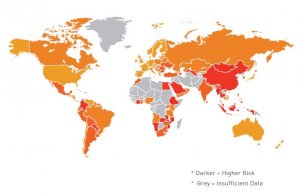EXECUTIVE SUMMARY:
Did 2021 hurl your organization into survival mode? The past 12 months represent one of the most turbulent and disruptive periods on record, at least as far as security is concerned, according to experts. The world has witnessed a profusion of attacks; from the Kaseya ransomware incident to the Log4j vulnerabilities. Leading industries and economic sectors have seen a ~55% increase in cyber attacks.
“The education and research sectors appear to have suffered the greatest blow, weathering an average of 1,605 attacks on a weekly basis,” says data researcher Omer Dembinsky. Further details pertaining to global attack trends are described in the Cyber Attack Trends: 2022 Security Report, presented by Check Point Software. What can the past tell us about the future?
Report highlights
The frequency of cyber attacks directed towards organizations tends to vary by geographic locale. Comparatively speaking, lower cyber-risk regions include Australia, much of Western Europe, and the United States. Higher cyber-risk regions include Northern Asia, portions of the Middle East, and select countries in Southern Africa.

In the report, informative charts also depict the percentage of corporate networks attacked by specific varieties of malware. Notably, botnets topped the global chart as the most common malware form, followed by infostealers and cryptominers. Ransomware took last place.
Further report highlights
The Cyber Attack Trends: 2022 Security Report points to key issues to keep an eye on across this coming year. These include:
- Supply chain attacks. In 2020, the infamous SolarWinds attack set the foundations for a series of software supply chain attacks. In 2021, we witnessed the Kaseya supply chain attack and chaos caused by the Log4j vulnerability. These events emphasize the seriousness of this often overlooked potential threat.
- Cloud services attacks. Last year, cloud provider vulnerabilities came to light. The vulnerabilities that were exposed allow hackers to execute arbitrary code, escalate to root privileges, access large amounts of private content and go back-and-forth between different environments.
- Mobile security threats. In recent months, cyber criminals have accelerated their use of smishing (SMS phishing) tactics. Many of the fraudulent mobile schemes appear to emanate from banks and large institutions that would never send customers unsolicited text messages. Because people commonly respond to text messages as quickly as possible and hastily follow text-message instructions, smishing represents a very real threat.
- Ransomware returns. Although ransomware gangs are still operating in full-force, governments, law-enforcement agencies and private sector groups have collaborated on new initiatives to stop ransomware attacks. These initiatives are gradually disrupting the ransomware ecosystem, and continued progress against ransomware is expected in 2022.
Get the report
The Cyber Attack Trends: 2022 Security Report gives a detailed overview of the cyber threat landscape. These findings are based on data drawn from Check Point Software’s ThreatCloud intelligence platform between January and December of 2021, and highlight the core tactics that cyber criminals use to attack organizations.
By understanding the latest trends, you can contribute valuable insights within corporate dialogues, develop a more targeted security strategy for your business, and proactively prevent attacks. Get the report here.




